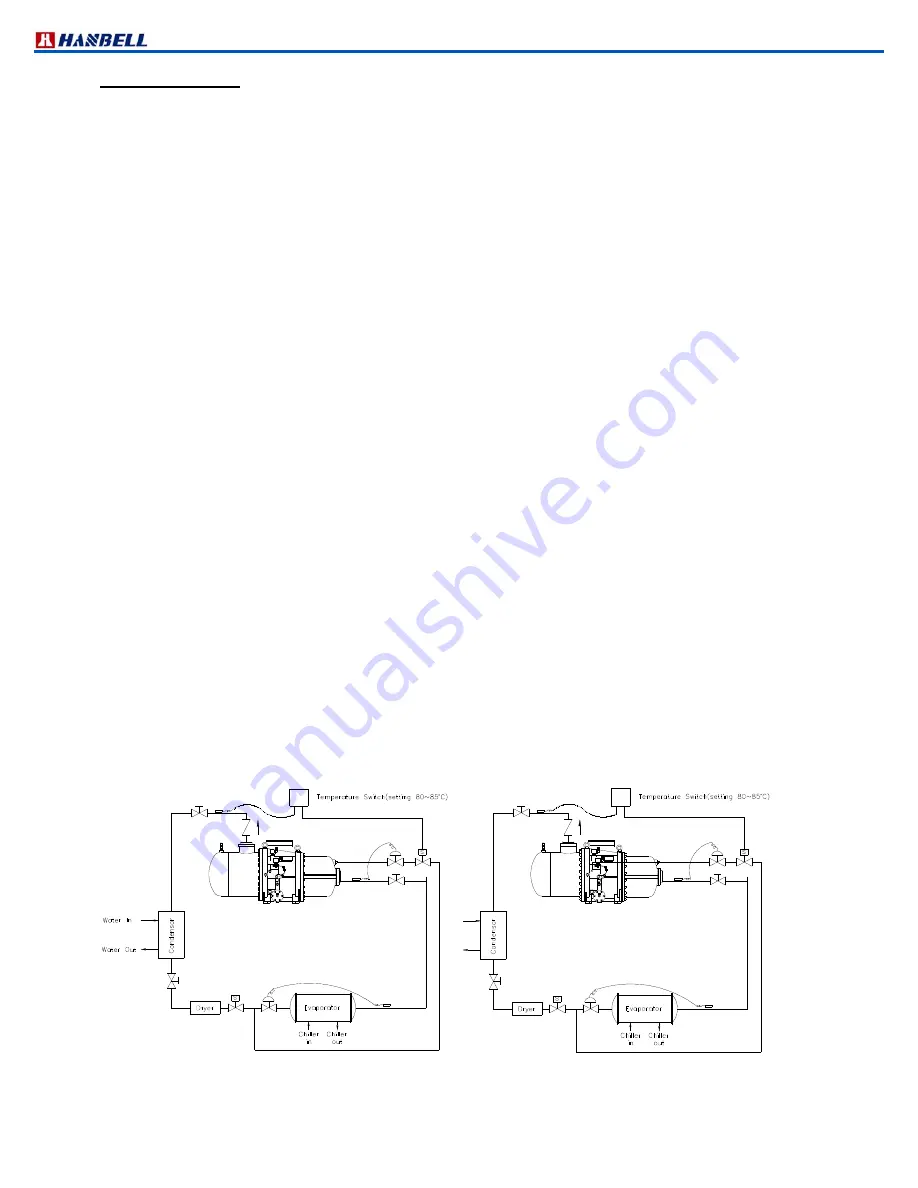
Technical Manual
VERSION 2.0 -10-18-2018
70
7. Applications
7.1 Additional cooling
When compressors operate in the following application conditions, installation of an additional auxiliary cooling
apparatus is recommended to lower discharge temperature, maintain proper temperature of lubricant and additional
cooling for motor coil to ensure safe running of compressors with efficiency.
Aircooled system
High compression ratio system such as heat pump, low temperature and refrigeration system
High discharge temperature system such as heat recovery system
If compressors have to run at partial load below 50% continuously in a long term.
Any other heavy duty application
There are two type of additional cooling of compressor that described separately as below.
a. Liquid injection applications
In areas with high condensing temperature and/or low evaporating temperature as in the limitation diagram, additional
cooling is required in order for the compressor to work properly. A relatively simple method of additional cooling is
direct refrigerant injection in the compressor either in the motor side or compression chamber side.
The purpose of installing a liquid injection system is to prevent the compressor from overheat. The system installed a
liquid injection expansion valve between the liquid line and compressor for cooling down the compression chamber and
motor to ensure the continuous and safe running of the compressor. The suction superheat should be controlled
between 5K~10K for the application of aircooled and heat pump chillers by means of expansion valve devices. These
devices can be adjusted by the stem of the expansion valve to control the suction superheat by means of refrigerant
flow rate. When the initial startup, the loading of the chiller is heavy due to the high temperature of chilled water, so the
liquid injection devices capacity should be selected or calculated enough to reduce the overheat of the compressor.
Calculating the cooling capacity of liquid injection devices
Liquid injection devices can be calculated with the
HANBELL selection software
or manually. For manual calculation,
consider the most extreme conditions to be expected during actual operations i.e. minimum evaporating temperature,
maximum suction gas super heat and condensing temperature.
Liquid injection applied with low temperature expansion valve
When the compressor applied in the low
≦
temperature system (E.T. 10°C) the compression ratio is high at this
condition, also the discharge temperature will be very high. The design of the liquid injection system for low
temperature application is similar to the illustration shown in figure below. There are two connectors for the liquid
injection in the compressor, one is in the motor side to cool down the motor temperature and reduce the discharge
temperature. The other is in the compression chamber side and its function is to reduce the discharge temperature and
increase the compression efficiency. However, when additional cooling in compression chamber like economizer
operation, oil cooler application is used or when condensing temperature is low, discharge temperature will be kept low
and liquid injection may not be turned on, although motor load is severe and motor coil temperature is high. This may
lead to motor failure. Therefore, in application mentioned above Pt100 or Pt1000 for liquid injection to motor is
recommended instead.
Figure 59 Liquid injection connected to motor Figure 60 Liquid injection connected to compression chamber
Summary of Contents for RC2 Series
Page 24: ...Technical Manual VERSION 2 0 10 18 2018 24 UNIT SI mm Imperial in UNIT SI mm Imperial in ...
Page 25: ...Technical Manual VERSION 2 0 10 18 2018 25 SI mm Imperial in UNIT UNIT SI mm Imperial in ...
Page 26: ...Technical Manual VERSION 2 0 10 18 2018 26 SI mm Imperial in UNIT UNIT SI mm Imperial in ...
Page 27: ...Technical Manual VERSION 2 0 10 18 2018 27 UNIT SI mm Imperial in ...
Page 28: ...Technical Manual VERSION 2 0 10 18 2018 28 ...
Page 29: ...Technical Manual VERSION 2 0 10 18 2018 29 UNIT SI mm Imperial in ...
Page 30: ...Technical Manual VERSION 2 0 10 18 2018 30 ...
Page 31: ...Technical Manual VERSION 2 0 10 18 2018 31 ...
Page 32: ...Technical Manual VERSION 2 0 10 18 2018 32 ...
Page 33: ...Technical Manual VERSION 2 0 10 18 2018 33 ...
Page 34: ...Technical Manual VERSION 2 0 10 18 2018 34 UNIT SI mm Imperial in ...
Page 35: ...Technical Manual VERSION 2 0 10 18 2018 35 2 RC2 B outline drawings ...
Page 36: ...Technical Manual VERSION 2 0 10 18 2018 36 ...
Page 37: ...Technical Manual VERSION 2 0 10 18 2018 37 ...
Page 38: ...Technical Manual VERSION 2 0 10 18 2018 38 ...
Page 39: ...Technical Manual VERSION 2 0 10 18 2018 39 ...
Page 40: ...Technical Manual VERSION 2 0 10 18 2018 40 ...
Page 41: ...Technical Manual VERSION 2 0 10 18 2018 41 ...
Page 42: ...Technical Manual VERSION 2 0 10 18 2018 42 ...
Page 43: ...Technical Manual VERSION 2 0 10 18 2018 43 ...
Page 44: ...Technical Manual VERSION 2 0 10 18 2018 44 SI mm Imperial in UNIT ...
Page 60: ...Technical Manual VERSION 2 0 10 18 2018 60 ...
Page 83: ...Technical Manual VERSION 2 0 10 18 2018 83 NOTES ...















































